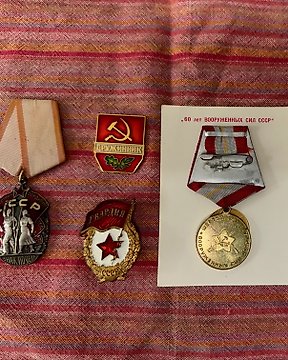
Rusia - Medalie - 1940
Nr. 83842997

Nr. 83842997

Lot Contain 2 Austria-Hungaria War Medals
And Gift
1. War Medal 2 December 1873 (Kriegsmedaille)
Established by Emperor Franz Joseph I on December 2, 1873. Initially, it had the status of a commemorative medal and was awarded to military personnel to commemorate the 25th anniversary of the emperor’s accession to the throne.
Initially, the medal was awarded to all military personnel who, at the time of its establishment, had been in active service in the army since December 2, 1848, that is, from the date of the emperor’s accession to the throne of the dual monarchy, and who had taken part in at least one battle during this period.
These included the following:
Austro-Italian War of 1848-1849.
suppression of the Hungarian uprising of 1848-1849.
Austro-Italian-French War of 1859.
campaigns in Schleswig and Jutland during the Danish War of 1864.
campaigns in Bohemia and southern Germany during the Austro-Prussian War of 1866.
campaign in Tyrol during the Austro-Prussian War of 1866.
suppression of the uprising in South Dalmatia in 1869.
The War Medal was automatically awarded to holders of the following Austrian awards: Commemorative Medal for the People's Defense of the Tyrol 1848, Commemorative Medal for the War of 1864 against Denmark, Commemorative Medal for the People's Defense of the Tyrol 1866 and the Medal of the Prague Militia 1866.
Subsequently, the criteria for awarding the Military Medal changed, and it became an insignia for military merit in subsequent conflicts. Thus, the award was awarded in 1878-1880 to participants in the successful campaign to annex Bosnia and Herzegovina to Austria-Hungary in accordance with the provisions of the Berlin Congress. Then the medal was awarded to military personnel who took part in the suppression of the Bosnian-Herzegovinian uprising of 1882 and similar events of the same year in Southern Dalmatia.
The award was then presented in 1900-1901 to members of the Austro-Hungarian Expeditionary Force (75 men in total) sent to Qing China to suppress the Yihetuan (Boxer) Rebellion as part of the military intervention of the Eight Power Alliance. It is known that 20 Austrian sailors and junior non-commissioned officers, 1 Fenrich and 1 naval cadet took part in the assault on the Taku forts.
This is one of the most common medals of Austria-Hungary; over a long time it was given to many categories of persons, therefore there are a lot of differences in details. The medal was made in different places and workshops from different metals: copper, copper alloys and zinc. There are medals with a diameter from 36 mm to 37.5 mm. The weight of copper ones is 19-25 grams, zinc ones weigh slightly less. The thickness of the edge of the medals is from 2.4 mm to 3 mm.
Obverse.
The obverse of the medal depicts a right-facing portrait of Emperor Franz Joseph I, crowned with a laurel wreath. Around the circle there is an inscription in capital letters 5 mm high: “Franz Joseph I, Emperor of Austria, King of Bohemia, etc., Apostolic King of Hungary.” In the lower part there is a small six-pointed, less often a five-pointed asterisk. There are two types of obverse, differing in the spelling of the words “Emperor”, “Austria”, “King” and “Bohemia”: “Franz Josef I. Kaiser v. Österreich König v. Böhmen etc. Apost. König v. Ungarn" and "Franz Josef I. Kais. v. Oesterreich Koenig v. Boehm. etc. Apost. Koenig v. Ungarn.” It is worth noting that the nature of the spelling of these words, i.e. the use of diacritics with an umlaut or digraphs depended on language preferences: if the first letters are characteristic of the German language, then the second ones are characteristic of Latin. In most medals, the above inscription was surrounded at the bottom by a narrow ring; in some it was missing.
Reverse.
In the center is the date of establishment of the award: “December 2, 1873” framed by a wreath of laurel (left) and oak (right) branches tied with a ribbon at the bottom. And again, two variants of the medal are known based on the type of spelling of the word “December”: the Latin one – “2.December 1873” and the rarer German one – “2.Dezember 1873”. The reverses also differed in the writing of the number “2” (straight and curly “two”).
_________________
Medal of Tyrolean veterans of World War 1 (1914-1918). Established in 1928. Austria. Bronze. Diameter – 33 mm.
Reward Description:
Obverse: image of a crowned eagle - the Austrian coat of arms.
Reverse: inscription (German) DAS LAND TIROL DEN VERTEIDIGERN DES VATERLANDES (THE PROVINCE OF TYROLE, FOR DEFENDERS OF THE FATHERLAND) and the dates of World War I - 1914-1918
Careful Packing and Shipping from JMEDALS -Lithuania
I'm do not Combine Shipping
Good luck!
Cum să cumperi de la Catawiki
1. Descoperă ceva special
2. Plasează cea mai mare ofertă
3. Fă o plată sigură